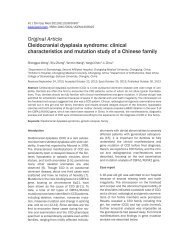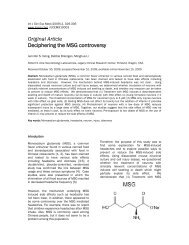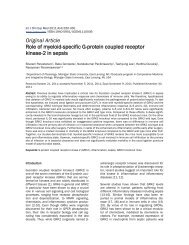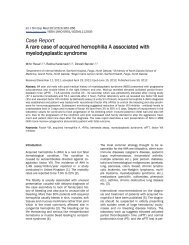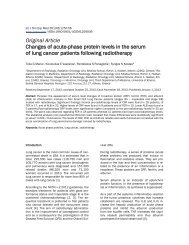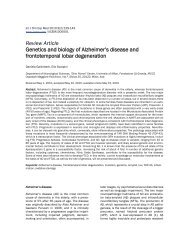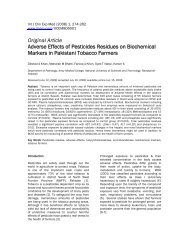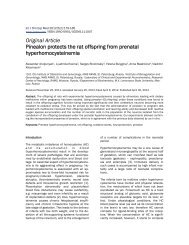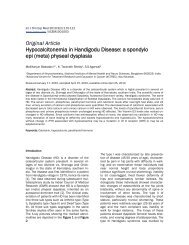Multiple different laminar velocity profiles in separate veins in the ...
Multiple different laminar velocity profiles in separate veins in the ...
Multiple different laminar velocity profiles in separate veins in the ...
You also want an ePaper? Increase the reach of your titles
YUMPU automatically turns print PDFs into web optimized ePapers that Google loves.
Lam<strong>in</strong>ar <strong>velocity</strong> <strong>in</strong> microvascular network of bra<strong>in</strong><br />
tative differences <strong>in</strong> <strong>the</strong> microvascular response<br />
to <strong>in</strong>flammation that are known to be prevalent<br />
<strong>in</strong> <strong>the</strong> bra<strong>in</strong> [4] and that are known to be <strong>different</strong><br />
to that seen <strong>in</strong> o<strong>the</strong>r organs such as <strong>the</strong><br />
liver, skeletal muscle, and mesentery [5-8]; differences<br />
that have led to a new evolv<strong>in</strong>g paradigm<br />
for blood cell-endo<strong>the</strong>lial cell <strong>in</strong>teraction <strong>in</strong><br />
this organ [4].<br />
Figure 1. OPS image of <strong>the</strong> bra<strong>in</strong> microvasculature <strong>in</strong><br />
<strong>the</strong> surface tissue after open<strong>in</strong>g of <strong>the</strong> dura. Central<br />
<strong>in</strong> <strong>the</strong> image is a larger venule (V) and <strong>the</strong> artery (A).<br />
Arrows <strong>in</strong>dicate flow direction (large (V) and small<br />
venule). The Bar corresponds to 100 µm. In <strong>the</strong> center<br />
of <strong>the</strong> larger venule, <strong>the</strong>re is a white streak <strong>in</strong>dicat<strong>in</strong>g<br />
<strong>the</strong> border between <strong>the</strong> two <strong>lam<strong>in</strong>ar</strong> flow <strong>profiles</strong><br />
generated by <strong>the</strong> two ve<strong>in</strong>s merg<strong>in</strong>g at <strong>the</strong> top of<br />
<strong>the</strong> image. In <strong>the</strong> left lower corner yet a third venule<br />
is jo<strong>in</strong><strong>in</strong>g and <strong>the</strong>reby add<strong>in</strong>g a third <strong>lam<strong>in</strong>ar</strong> flow<br />
profile.<br />
Material and methods<br />
Animal experiment<br />
Twenty female rats (Sprague-Dawley, B&K Universal,<br />
Sollentuna, Sweden) weigh<strong>in</strong>g from 250<br />
to 270g were used. The rats were housed two to<br />
a cage at a constant room temperature (21°C)<br />
for 3 days before operation, with free access to<br />
water and standard rat chow, and with 12-hour<br />
light/dark cycles.<br />
Anaes<strong>the</strong>sia was <strong>in</strong>duced with 4 % isoflurane<br />
(Forene ® 250ml, Abbott, Scand<strong>in</strong>avia AB, Kista,<br />
Sweden) <strong>in</strong> a mixture (30%:70%) of oxygen:nitrous<br />
oxide <strong>in</strong> a specially designed box. A<br />
soft endotracheal tube was used for controlled<br />
ventilation (Zoovent, CWC600AP), ULV, Newport,<br />
UK) us<strong>in</strong>g 1% isoflurane <strong>in</strong> a mixture<br />
(30%:70%) of oxygen:nitrous oxide. The tidal<br />
volume and ventilation frequency were carefully<br />
regulated us<strong>in</strong>g on-site monitor<strong>in</strong>g of blood<br />
gases and acid/base status (AVL, OPTI 1 Medical<br />
Nordic AB, Stockholm, Sweden). A longact<strong>in</strong>g<br />
non-steroidal anti-<strong>in</strong>flammatory, carpofen<br />
(Rimadyl ® , Pfizer, Dundee, Scotland) 0.1ml/kg<br />
was given at <strong>the</strong> beg<strong>in</strong>n<strong>in</strong>g of <strong>the</strong> operation [9].<br />
Microvascular preparation of <strong>the</strong> bra<strong>in</strong><br />
A bone flap (0.5 × 0.5 cm²) created <strong>in</strong> <strong>the</strong><br />
bregma region of rat’s temporal bone along <strong>the</strong><br />
sagittal suture was removed and <strong>the</strong> dura<br />
opened. A small volume was isolated on <strong>the</strong><br />
Figure 2. Schematic draw<strong>in</strong>g of <strong>the</strong> multi <strong>lam<strong>in</strong>ar</strong> flow <strong>profiles</strong>, generated by <strong>the</strong> add-on of each and more venular<br />
vessels <strong>in</strong> <strong>the</strong> microvascular bed of <strong>the</strong> bra<strong>in</strong>. In <strong>the</strong> illustration, <strong>the</strong> blood corpuscles from <strong>the</strong> branch vessels (c) and<br />
(b) do not mix/comb<strong>in</strong>e after flow<strong>in</strong>g <strong>in</strong>to a larger ve<strong>in</strong> (a), and cont<strong>in</strong>ued to travel <strong>separate</strong>ly even after reach<strong>in</strong>g <strong>the</strong><br />
second ma<strong>in</strong> branch<strong>in</strong>g vessel (d). In this vessel (d), four <strong>separate</strong> <strong>lam<strong>in</strong>ar</strong> flows with <strong>different</strong> flow velocities are discernible.<br />
11 Int J Cl<strong>in</strong> Exp Med 2011;4(1):10-16



